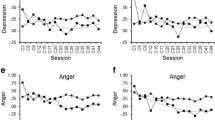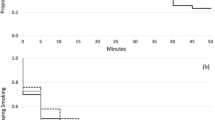Abstract
Rationale
Tobacco withdrawal is a key factor in smoking relapse, but important questions about the withdrawal phenomenon remain.
Objectives
This research was intended to provide information about two core components of withdrawal (negative affect and craving): (1) how various withdrawal symptom profile dimensions (e.g., mean level, volatility, extreme values) differ between negative affect and craving; and (2) how these dimensions relate to cessation outcome.
Methods
Adult smokers (N = 1,504) in a double-blind randomized placebo-controlled smoking cessation trial provided real-time withdrawal symptom data four times per day for 4 weeks (2 weeks pre-quit and 2 weeks post-quit) via palmtop computers. Cessation outcome was biochemically confirmed 8-week point-prevalence abstinence.
Results
Examination of craving and negative affect dimensions following a cessation attempt revealed that craving symptoms differed from negative affect symptoms, with higher means, greater variability, and a greater incidence of extreme peaks. Regression analyses revealed that abstinence was associated with lower mean levels of both craving and negative affect and fewer incidences of extreme craving peaks. In a multivariate model, the increase in mean craving and negative affect scores each uniquely predicted relapse.
Conclusions
Real-time reports revealed different patterns of abstinence-related negative affect and craving and that dimensions of both predict cessation outcome, suggesting that negative affect and craving dimensions each has motivational significance. This underscores the complexity of withdrawal as a determinant of relapse and the need to measure its distinct components and dimensions.




Similar content being viewed by others
Notes
Data from the first and last 2 days of recording were unrepresentative of the other recording days based on both completion rate and mean values.
While our previous research using HLM analyses has generally returned nonsignificant results in regard to negative affect once accounting for craving, the estimates for negative affect generally show poorer reliability due to the variability in symptom endorsement, especially the intermittent symptom spikes, as seen in the current analysis.
References
Acri JB, Grunberg NE (1992) A psychophysical task to quantify smoking cessation-induced irritability: the reactive irritability scale (RIS). Addict Behav 17:587–601
American Psychiatric Association (1994) Diagnostic and statistical manual of mental disorders, 4th edn. American Psychiatric Association
Baker TB, Piper ME, McCarthy DE, Majeskie MR, Fiore MC (2004) Addiction motivation reformulated: an affective processing model of negative reinforcement. Psychol Rev 111:33–51
Cappelleri JC, Bushmakin AG, Baker CL, Merikle E, Olufade AO, Gilbert DG (2005) Revealing the multidimensional framework of the Minnesota nicotine withdrawal scale. Curr Med Res Opin 21:749–760
Dawkins L, Powell JH, Pickering A, Powell J, West R (2009) Patterns of change in withdrawal symptoms, desire to smoke, reward motivation and response inhibition across 3 months of smoking abstinence. Addiction 104:850–858
Etter JF, Hughes JR (2006) A comparison of the psychometric properties of three cigarette withdrawal scales. Addiction 101:362–372
Gloria R, Angelos L, Schaefer HS, Davis JM, Majeskie M, Richmond BS, Curtin JJ, Davidson RJ, Baker TB (2009) An fMRI investigation of the impact of withdrawal on regional brain activity during nicotine anticipation. Psychophysiology 46:681–693
Heatherton TF, Kozlowski LT, Frecker RC, Fagerstrom KO (1991) The Fagerstrom Test for Nicotine Dependence: a revision of the Fagerstrom Tolerance Questionnaire. Br J Addict 86:1119–1127
Hosmer DW, Lemeshow S (2000) Applied Logistic Regression, 2nd edn. John Wiley & Sons, Inc.
Hughes JR (2007a) Effects of abstinence from tobacco: etiology, animal models, epidemiology, and significance: a subjective review. Nicotine Tob Res 9:329–339
Hughes JR (2007b) Effects of abstinence from tobacco: valid symptoms and time course. Nicotine Tob Res 9:315–327
Hughes JR (2007c) Measurement of the effects of abstinence from tobacco: a qualitative review. Psychol Addict Behav 21:127–137
Javitz HS, Brigham J, Lessov-Schlaggar CN, Krasnow RE, Swan GE (2009) Association of tobacco dependence and quit attempt duration with Rasch-modeled withdrawal sensitivity using retrospective measures. Addiction 104:1027–1035
Leventhal AM, Waters AJ, Moolchan ET, Heishman SJ, Pickworth WB (2010) A quantitative analysis of subjective, cognitive, and physiological manifestations of the acute tobacco abstinence syndrome. Addict Behav 35:1120–1130
McCarthy DE, Piasecki TM, Fiore MC, Baker TB (2006) Life before and after quitting smoking: an electronic diary study. J Abnorm Psychol 115:454–466
McClernon FJ, Kozink RV, Lutz AM, Rose JE (2009) 24-h smoking abstinence potentiates fMRI-BOLD activation to smoking cues in cerebral cortex and dorsal striatum. Psychopharmacology (Berl) 204:25–35
McDonough BE, Warren CA (2001) Effects of 12-h tobacco deprivation on event-related potentials elicited by visual smoking cues. Psychopharmacology (Berl) 154:282–291
McRobbie H, Hajek P, Locker J (2008) Does the reaction of abstaining smokers to the smell of other people's cigarettes predict relapse? Addiction 103:1883–1887
O'Connell KA, Schwartz JE, Shiffman S (2008) Do resisted temptations during smoking cessation deplete or augment self-control resources? Psychol Addict Behav 22:486–495
Perkins KA (2009a) Acute responses to nicotine and smoking: implications for prevention and treatment of smoking in lower SES women. Drug Alcohol Depend 104(Suppl 1):S79–S86
Perkins KA (2009b) Does smoking cue-induced craving tell us anything important about nicotine dependence? Addiction 104:1610–1616
Perkins KA, Briski J, Fonte C, Scott J, Lerman C (2009) Severity of tobacco abstinence symptoms varies by time of day. Nicotine Tob Res 11:84–91
Perkins KA, Karelitz JL, Conklin CA, Sayette MA, Giedgowd GE (2010) Acute negative affect relief from smoking depends on the affect situation and measure but not on nicotine. Biol Psychiatr 67:707–714
Piasecki TM, Fiore MC, Baker TB (1998) Profiles in discouragement: two studies of variability in the time course of smoking withdrawal symptoms. J Abnorm Psychol 107:238–251
Piasecki TM, Jorenby DE, Smith SS, Fiore MC, Baker TB (2003a) Smoking withdrawal dynamics: I. Abstinence distress in lapsers and abstainers. J Abnorm Psychol 112:3–13
Piasecki TM, Jorenby DE, Smith SS, Fiore MC, Baker TB (2003b) Smoking withdrawal dynamics: II. Improved tests of withdrawal-relapse relations. J Abnorm Psychol 112:14–27
Piasecki TM, Jorenby DE, Smith SS, Fiore MC, Baker TB (2003c) Smoking withdrawal dynamics: III. Correlates of withdrawal heterogeneity. Exp Clin Psychopharmacol 11:276–285
Piasecki TM, Niaura R, Shadel WG, Abrams D, Goldstein M, Fiore MC, Baker TB (2000) Smoking withdrawal dynamics in unaided quitters. J Abnorm Psychol 109:74–86
Piper ME, Federmen EB, McCarthy DE, Bolt DM, Smith SS, Fiore MC, Baker TB (2008) Using mediational models to explore the nature of tobacco motivation and tobacco treatment effects. J Abnorm Psychol 117:94–105
Piper ME, Piasecki TM, Federman EB, Bolt DM, Smith SS, Fiore MC, Baker TB (2004) A multiple motives approach to tobacco dependence: the Wisconsin inventory of smoking dependence motives (WISDM-68). J Consult Clin Psychol 72:139–154
Piper ME, Smith SS, Schlam TR, Fiore MC, Jorenby DE, Fraser D, Baker TB (2009) A randomized placebo-controlled clinical trial of 5 smoking cessation pharmacotherapies. Arch Gen Psychiatr 66:1253–1262
Shiffman S, Ferguson SG, Gwaltney CJ, Balabanis MH, Shadel WG (2006a) Reduction of abstinence-induced withdrawal and craving using high-dose nicotine replacement therapy. Psychopharmacology (Berl) 184:637–644
Shiffman S, Gnys M, Richards TJ, Paty JA, Hickcox M, Kassel JD (1996) Temptations to smoke after quitting: a comparison of lapsers and maintainers. J Health Psychol 15:455–461
Shiffman S, Kirchner TR (2009) Cigarette-by-cigarette satisfaction during ad libitum smoking. J Abnorm Psychol 118:348–359
Shiffman S, Patten C, Gwaltney C, Paty J, Gnys M, Kassel J, Hickcox M, Waters A, Balabanis M (2006b) Natural history of nicotine withdrawal. Addiction 101:1822–1832
Shiffman S, Paty JA, Gwaltney CJ, Dang Q (2004a) Immediate antecedents of unrestricted smoking patterns. J Abnorm Psychol 113:166–171
Shiffman S, West R, Gilbert D (2004b) Recommendation for the assessment of tobacco craving and withdrawal in smoking cessation trials. Nicotine Tob Res 6:599–614
Siegel S (1977) Learning and psychopharmacology. Appleton-Century-Crofts
Spiga R, Bennett RH, Schmitz J, Cherek DR (1994) Effects of nicotine on cooperative responding among abstinent male smokers. Behav Pharmacol 5:337–343
Stone AA, Shiffman S (2002) Capturing momentary self-report data: a proposal for reporting guidelines. Ann Behav Med 24:236–243
Sweeney CT, Pillitteri JL, Kozlowski LT (1996) Measuring drug urges by questionnaire: do not balance scales. Addict Behav 21:199–204
U.S. Dept. of Health and Human Services (1988) The health consequences of smoking: nicotine addiction. U.S. Department of Health and Human Services, Centers for Disease Control and Prevention, National Center for Chronic Disease Prevention and Health Promotion, Office on Smoking and Health, Atlanta
Welsch SK, Smith SS, Wetter DW, Jorenby DE, Fiore MC, Baker TB (1999) Development and validation of the Wisconsin smoking withdrawal scale. Exp Clin Psychopharmacol 7:354–361
Wikler A (1965) Conditioning factors in opiate addictions and relapse. In: Kassebaum DMWGG (ed) Narcotics. McGraw-Hill, New York, pp 85–100
Zhou X, Nonnemaker J, Sherrill B, Gilsenan AW, Coste F, West R (2009) Attempts to quit smoking and relapse: factors associated with success or failure from the ATTEMPT cohort study. Addict Behav 34:365–373
Acknowledgments
This research was conducted at the University of Wisconsin, Madison and was supported by grant #P50 DA019706 from NIH/NIDA and by grant #M01 RR03186 from the General Clinical Research Centers Program of the National Center for Research Resources, NIH. Dr. Piper was supported by grant 1UL1RR025011 from the Clinical and Translational Science Award (CTSA) program of the National Center for Research Resources (NCRR), National Institutes of Health (NIH). Dr. Cook was supported by K08DA021311. Dr. Baker was supported via NCI 1K05CA139871. Dr. Loh was partially supported by U. S. Army Research Office grant W911NF-09-1-0205. Medication was provided to patients at no cost under a research agreement with GlaxoSmithKline (GSK); no part of this manuscript was written or edited by anyone employed by GSK.
Conflicts of interest
The authors declare that they have no potential conflicts of interest to disclose.
Author information
Authors and Affiliations
Corresponding author
Rights and permissions
About this article
Cite this article
Piper, M.E., Schlam, T.R., Cook, J.W. et al. Tobacco withdrawal components and their relations with cessation success. Psychopharmacology 216, 569–578 (2011). https://doi.org/10.1007/s00213-011-2250-3
Received:
Accepted:
Published:
Issue Date:
DOI: https://doi.org/10.1007/s00213-011-2250-3




